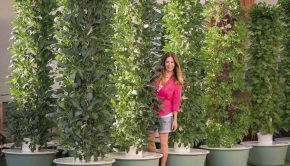Nature’s Wisdom, Its Lessons Inspire, Heal and Sustain Us
The environment is not separate from ourselves; we are inside it and it is inside us; we make it and it makes us. ~ Davi Kopenawa Yanomami, Amazon shaman
While the idea that we humans stand apart from—or even above—nature is a prevailing theme in much of modern civilization, naturalists and other clever souls throughout the ages have observed that the opposite is true: We are part of, depend on and evolve with nature—and we ignore this vital connection at our peril.
“If one way is better than another, that you may be sure is nature’s way,” admonished the Greek philosopher Aristotle, in the third century B.C.E.
“Time destroys the speculation of men, but it confirms the judgment of nature,” Roman politician and philosopher Cicero ruminated two centuries later.
Nobel Prize-winning physicist and philosopher Albert Einstein remarked, “Look deep into nature, and then you will understand everything better.”
Today, more of us are looking to nature for ways to improve physical, mental and emotional health, develop intelligence, innovate, overhaul how we build homes and neighborhoods, and raise our children.
Healthful Nature
As Henry David Thoreau wrote in his classic 1854 book Walden, “We need the tonic of wildness.”
While we know firsthand how walking in the woods can elevate mood, scientists have documented that a regular dose of nature has other far-reaching benefits. It can lower stress hormone levels, blood pressure and undesirable cholesterol; help heal neurological problems; hasten fuller recovery from surgery and heart attacks; increase cancer-fighting white blood cells; and generally aid overall health (Health Promotion International research report; also Nippon Medical School study, Tokyo).
Regular playtime outdoors helps children cope with hyperactivity and attention deficit disorders, according to research published in Current Problems in Pediatric and Adolescent Health Care.
Exposure to nature can help adults escape from today’s wired lives; reinvigorate, be fitter and less likely to suffer from obesity, diabetes and heart disease, as reported in studies published in the American Journal of Clinical Nutrition and a University of Washington research summary. It can also unlock understanding of the spiritual essence of life.
Hours regularly spent by youth outdoors stimulate imagination and creativity and enhance cognitive development, helping them learn. Nature also helps youngsters develop social awareness, helping them better navigate human relations (Tinyurl.com/OutdoorHealthBenefitsResearch).
“It’s strange and kind of sad that we are so removed from nature that we actually have to ask why nature is good for us,” says Dr. Eva Selhub, a lecturer at Harvard Medical School, author of the new book Your Health Destiny, and co-author of Your Brain on Nature. “The fact is our brains and bodies are wired in concert with nature.”
Recognition of nature’s positive effects has grown so much in recent years that physicians increasingly write their patients “prescriptions” to go hiking in the woods, counting on the healthy exercise and exposure to sunlight, nature and soothing views to address health problems stemming from poor diets and sedentary lifestyles. Healthcare clinics and hospitals in Washington, D.C., New York City, Chicago, Indianapolis, Albuquerque, New Mexico, California’s Bay Area and elsewhere have launched Prescription Trails programs aimed at objectives from preventing obesity in children to healthful activities for retirees (Tinyurl.com/AmericanHealthTrails).
Bestselling author Richard Louv calls the positive nature effect “vitamin N” in The Nature Principle. He contends: “Many of us, without having a name for it, are using the nature tonic. We are, in essence, self-medicating with an inexpensive and unusually convenient drug substitute.”
Such ideas are commonly accepted in many cultures. The Japanese believe in the restorative power of shinrin-yoku, which could be translated as “forest medicine” or “forest bathing”. Indigenous peoples like the Brazilian tribe led by Shaman Davi Kopenawa Yanomami, fighting to preserve their land and way of life in the Amazon, profess to be at one with the innate riches of sustainable rainforests (SurvivalInternational.org/parks).
Innovative Nature
Nature has an unbelievable capacity for healing. ~David Miller, 10 Lessons from Nature to Inspire Our Everyday Lives
Scientists, inventors and other innovators are increasingly inspired by nature. Biomimicry, part social movement and part burgeoning industry, looks to how Earth’s natural systems work and solve problems. University of Utah researchers, inspired by the durable homes built by sandcastle worms, are creating a synthetic glue that one day could help repair fractured bones. Architectural components manufacturer Panelite makes energy-efficient insulated glass by mimicking the hexagonal structure that bees use in honeycombs. (Find other precedents at Tinyurl.com/BiomimicryCaseExamples).
The inspiration for biomimicry comes from many places, says Dayna Baumeister, Ph.D. co-founder of Biomimicry 3.8, a Missoula, Montana, company working with other companies and universities to propel biomimicry into the mainstream.
“People are recognizing that they’ve been disconnected to the natural world,” she says. “We also realize that [as a species] we are in trouble. We don’t have all the answers, but we can look to other species for inspiration” for clearing pollutants from our bodies and environments.
Plants and fungi are now commonly used to clean up old industrial sites that resemble nature’s way of removing pollutants from water and soil. A University of California, Berkeley, meta-study confirms that farmers currently using organic farming methods and solar power achieve roughly the same crop yields as conventional techniques with far less dependence on fossil fuels, reducing greenhouse gases and petrochemical pesticide and fertilizer pollution.
Cyclical Nature
Concepts that disengage us from other species hamper our thinking.~Jeremy Narby
These breakthrough technologies emulate the way nature uses the building blocks of life in an endless cycle of birth, reproduction, decay and rebirth. It’s part of a broad rethinking of the principles behind sustainability—building, manufacturing and living in greater harmony with natural systems, perhaps eventually eliminating landfills, air and water pollution, and toxic site cleanups.
“A toxin is a material in the wrong place,” says architect William McDonough, of Charlottesville, Virginia. The only individual recipient of the Presidential Award for Sustainable Development, he is co-author of Cradle-to-Cradle, a groundbreaking book that calls for re-envisioning even the nastiest waste, and The Upcycle: Beyond Sustainability—Designing for Abundance. McDonough imagines a world where waste becomes raw material for new buildings, furniture and other goods—akin to how a forest reuses every deceased tree and animal to nourish the ecosystem and spawn new life.
With 80 percent of U.S. residents currently living in urban areas, architects, builders and municipal planners are likewise pivoting toward nature, prompted by the scientific evidence of the many ways that human health and general well-being rely upon it. While this contact is preferably the kind of “stopping by woods” that inspired New England poet Robert Frost, even a walk in a city park will work.
“Urban nature, when provided as parks and walkways and incorporated into building design, provides calming and inspiring environments and encourages learning, inquisitiveness and alertness,” reports the University of Washington’s College of the Environment, in Green Cities: Good Health.
The American Planning Association stresses the importance of integrating green space into urban neighborhoods. Not only does so-called “metro nature” improve air and water quality and reduce urban heat island effects, urban wilds such as Pittsburgh’s Nine Mile Run and Charlotte, North Carolina’s Little Sugar Creek Greenway also restore natural connections in densely populated city centers.
Natural Intelligence
Man is everywhere a disturbing agent. Wherever he plants his foot, the harmonies of nature are turned to discord. The proportions and accommodations that ensured the stability of existing arrangements are overthrown. Of all organic beings, man alone is to be regarded as essentially a destructive power. ~ George Perkins Marsh, Man and Nature (1864)
A growing number of scientists say that research about our place in nature has sparked fresh thinking about our role and devastated quaint notions about our species’ superiority. “Single-celled slime molds solve mazes. Brainless plants make correct decisions and bees with brains the size of pinheads handle abstract concepts,” points out Anthropologist Jeremy Narby, author of the groundbreaking book Intelligence in Nature.
At a national conference of Bioneers, an organization based in Santa Fe, New Mexico, and San Francisco that gathers nature-minded social and scientific innovators, Narby said: “We are nearly identical to many animals. Many behaviors once thought to be exclusively human are shared by other species. The zone of the specifically human, as determined by science, has been shrinking.”
We haven’t lost the ability to tap that primal animal inside, even if most of us are more likely to “venture into the forest” by watching a movie or playing video games. We may feel cut off from our instincts, but studies show time in the woods can do wonders to restore the keenness of our senses to connect with the subtle changes in natural habitat, the movements of other species and the changing seasons.
The rise of human civilizations may have taken “survival of the fittest” in new directions, often decidedly tamer ones, but experts ranging from scientific researchers to lifestyle analysts say humankind is still hardwired by our more primitive past. Despite the ingenious ways we’ve devised to exploit other life forms, capitalize on Earth’s resources and protect ourselves from nature’s sometimes terrifying power, our fate remains linked to natural laws and limits, from nurturing our body’s immune system to resolving planet-sized problems like climate change.
“‘Nature’ is our natural environment,” according to Selhub. We don’t have to move to the country to reconnect, she says. “Even spending 20 minutes a day outside has an effect.” Houseplants, nature photos and aromatherapy Earth scents can also help indoor environments better reflect our own nature.
The wealth of research and common sense wisdom is aptly summed up by celebrated author Wendell Berry in The Long-Legged House. “We have lived our lives by the assumption that what was good for us would be good for the world. We have been wrong. We must change our lives so that it’ll be possible to live by the contrary assumption, that what is good for the world will be good for us. And that requires we make the effort to know the world and learn what is good for it.”
Christine MacDonald is a freelance journalist in Washington, D.C., whose specialties include health and science. Visit ChristineMacDonald.info.
True-Life ‘Aha!’ Reads
10 Lessons from Nature to Inspire Our Everyday Lives by David Miller,
Tinyurl.com/10InspiringLessonsFromNature
9 Amazing Lessons from Nature to Inspire Your Everyday Life by Annie Hauser,
Tinyurl.com/9InspiringLessonsFromNature
Intelligence in Nature by Jeremy Narby
Life Lessons from Nature by Elvis Newman
Cathedrals of the Spirit by T. C. McLuhan
Your Brain on Nature by Eva Selhub
<












